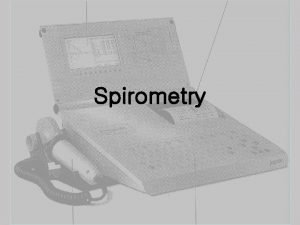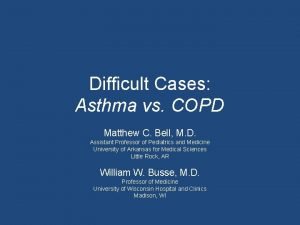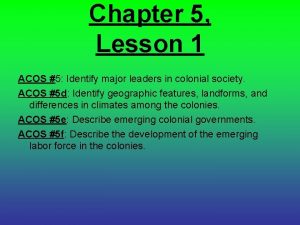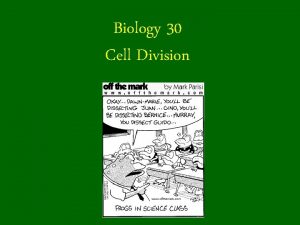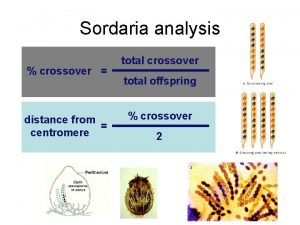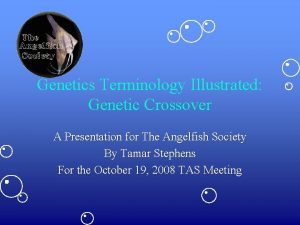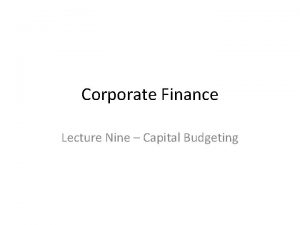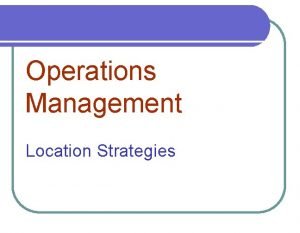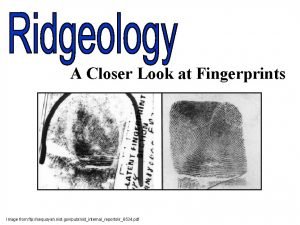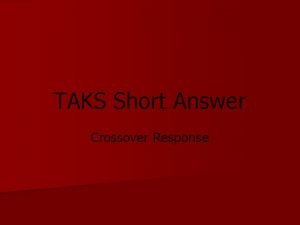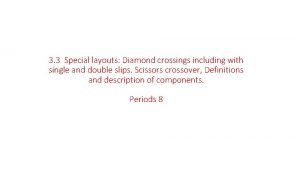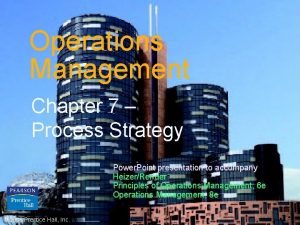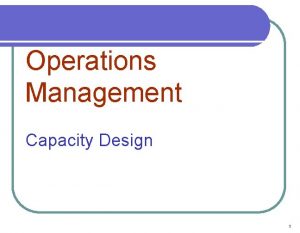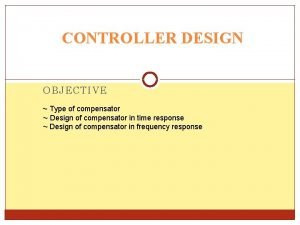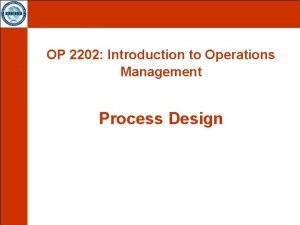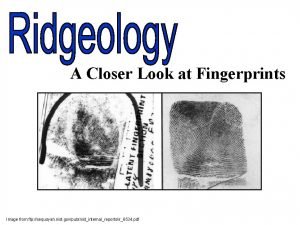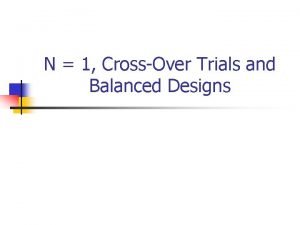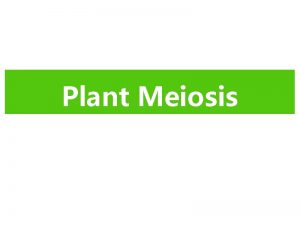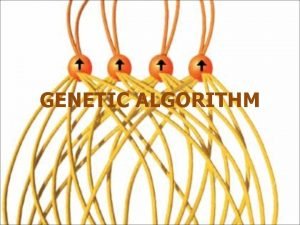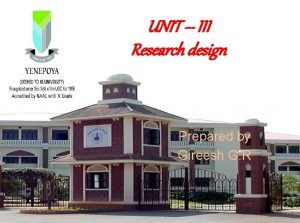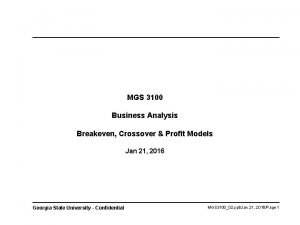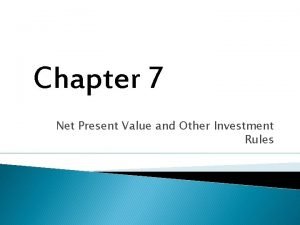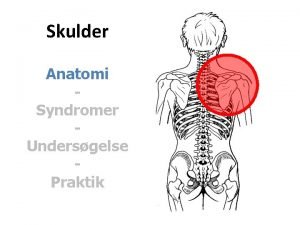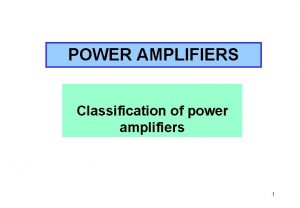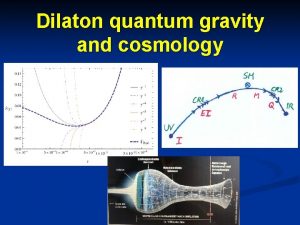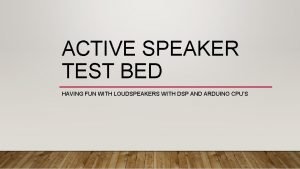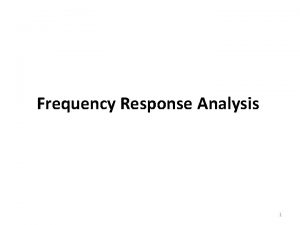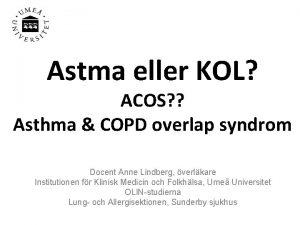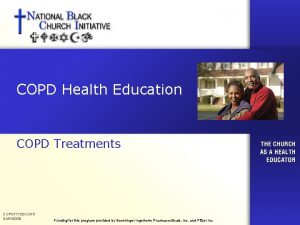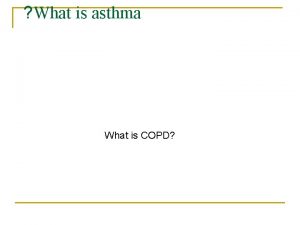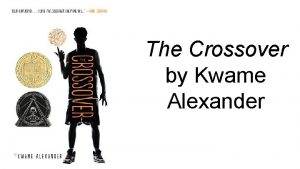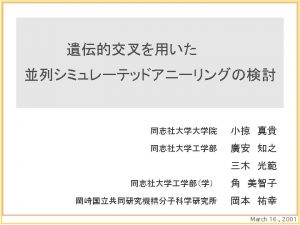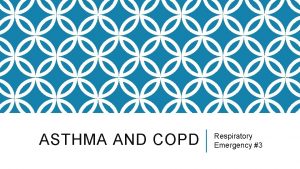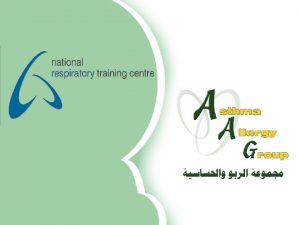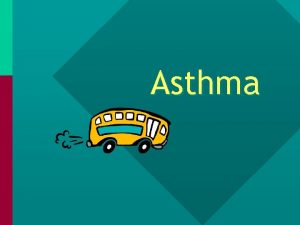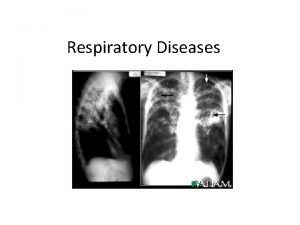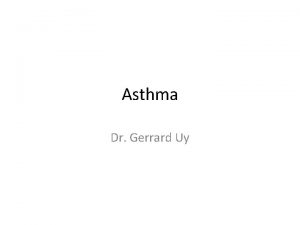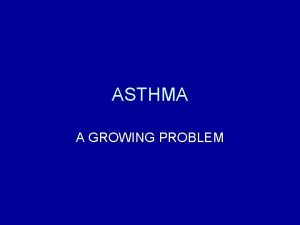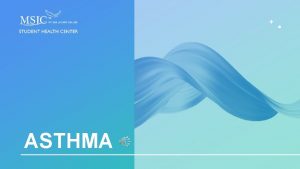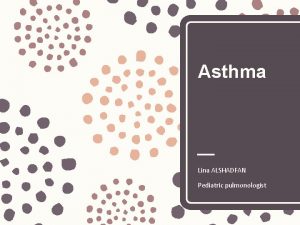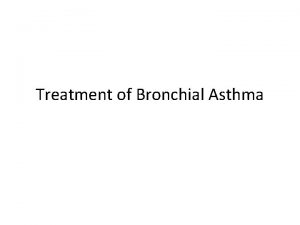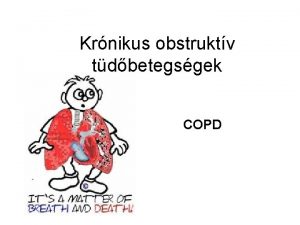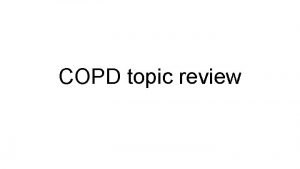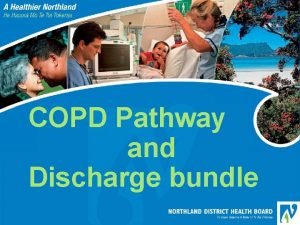Asthma or COPD or ACOS Asthma COPD crossover



































- Slides: 35

Asthma, or COPD, or ACOS (Asthma + COPD crossover Syndrome, or something else? And WHY does it matter which label? WECCG – time to Learn -- Respiratory 9 th July 2019

Some Treatment is the same • Asthma, COPD, ACOS, ILD etc: • ALL MUST have • Smoking cessation support • Agreed self management of exacerbations • Accurate diagnosis • Patient empowerment 9 th July 2019 WECCG 2

Some Treatment is different • Asthma – MUST have ICS • There is NO step 1 = SABA only • Mild COPD can be treated with LAMA/LABA – this can be fatal if patient has Asthma • Other Dx have different management 9 th July 2019 WECCG 3

Consider COPD if patient has: any of: • Dyspnoea • Chronic cough or sputum • Recurrent lower respiratory tract infections • Hx of exposure to risk (Smoke, weed, flour dust) 9 th July 2019 WECCG – GOLD Dx COPD 2019 4

COPD Must have: • Post bronchodilator Spirometry with FEV 1/FVC < 0. 70 • i. e. obstructive pattern, or • Mixed obstructive & restrictive 9 th July 2019 WECCG – GOLD Dx COPD 2019 5

Spirometry: age, height, M/F Volume In Litres FVC= forced vital capacity (3 -24 seconds) Normal only if both FEV 1 & FVC are ≥ Minimum PREDICTED based On Height, Age & Gender FEV 1= forced expiratory volume in 1 second FEV 1/FVC ≥ 80% is normal or restrictive TIME in seconds

Spirometry: NOT obstructive = NOT COPD Volume In Litres FVC= forced vital capacity (3 -24 seconds)LONGER Predicted FEV 1/FVC ≤ 70% is obstructive Obstructive: FEV 1= Lower & FVC = Normal compared to PREDICTED based On Height, Age & Gender FEV 1= forced expiratory volume in 1 second Reduced, but FVC is preserved! TIME in seconds

Spirometry: Restrictive = NOT COPD Volume In Litres FVC= forced vital capacity (3 -24 seconds)LONGER Predicted FEV 1/FVC more than 70% in RESTRICTIVE Restrictive: FEV 1 &FVC are BOTH Lower compared to PREDICTED based On Height, Age & Gender FEV 1= forced expiratory volume in 1 second Reduced, AND FVC reduced in proportion! TIME in seconds

Spirometry: MIXED = Restrictive + Obstructive Volume In Litres FVC= forced vital capacity (3 -24 seconds)LONGER Predicted FEV 1/FVC ≤ 70% is obstructive Restrictive: FVC is reduced, AND Obstructive because FEV 1 is even MORE Reduced, compared to PREDICTED based On Height, Age & Gender FEV 1= forced expiratory volume in 1 second Reduced, AND FVC is LESS reduced! TIME in seconds

Beware false restrictive • Moderate or severe COPD • With cough: • Cough, interrupts expiration • Terminates the blow at 1 -2 seconds. • FEV 1/FEV 1. 5 sec • False low FVC = false restrictive 9 th July 2019 WECCG 10

Spirometry in COPD: • MUST be Obstructive • NOT Obstructive = NOT COPD • Symptoms can be quite variable • BUT Spirometry varies ≤ 15% • Use POST bronchodilator Spirometry • If varies > 15% - consider Asthma • Asthma & COPD can co-exist

GOLD – COPD classification all must have FEV 1/Vcmax < 0. 7 • FEV 1 compared to predicted for height, age, gender: • GOLD 1 - Mild – FEV 1 ≥ 80% predict • GOLD 2–Moderate 50%≤FEV 1<80% • GOLD 3 -Severe 30%≤FEV 1<50% • GOLD 4 - Very Severe FEV 1 < 30% predicted 9 th July 2019 WECCG 12

MRC Dyspnoea scale 0 -1 • Grade 0: • Only breathless with strenuous exercise. • Grade 1: SOB when hurry on level or walk up slight hill 9 th July 2019 WECCG 13

MRC Dyspnoea scale 2, 3, 4 • Grade 2: Walk slower than others on level due SOB or have to stop for breath on my own on level. • Grade 3: Stop after walk 100 m or after few minutes on level • Grade 4: too breathless to leave house, or when dress/undressing 9 th July 2019 WECCG 14

CAT score – 8 items 0 -5 • Never cough – cough all the time • No plegm on chest – chest full mucus • Chest not tight at all – chest feels very tight • Walk up hill or 1 flight=NOT So. B – VERY breathless hill or 1 flight 9 th July 2019 WECCG 15

CAT score – last 4 items • Not limited any home activities – VERY limited doing activities at home • Confident leaving home – not confident to leave home due lungs • Sleep soundly – do not sleep due L. • Lots of energy – no energy at all 9 th July 2019 WECCG 16

GOLD refined ABCD • Symptoms & History fit? • FEV 1/Vcmax (post BD) < 0. 7 • FEV 1 % predicted: • Gold 1 ≥ 80% • Gold 2 50 -79 • Gold 3 30 -49 • Gold 4 < 30% 9 th July 2019 WECCG 17

Most cases= A, Freq. Flyer=D C= mild Sx + exacerbate D=severe Sx+ exacerbate A =Few B =Severe exacerbation, symptoms mild Symptoms + 0 or 1 exacerbations 9 th July 2019 WECCG 18

Exacerbation History • C or D • ≥ 2 exacerbations past year • Or ≥ 1 leading to admission • A or B • 0 or 1 exacerbation with hospital admission 9 th July 2019 WECCG 19

COPD Symptom score • A or C (left side) • m. MRC 0 -1 • CAT < 10 • B or D (right column) • m. MRC ≥ 2 • Or CAT ≥ 10 (out of max 40 ) 9 th July 2019 WECCG 20

Consider ASTHMA: • Symptoms varied, non-specific • Often: wheeze, dyspnea, cough (esp. at night & early am). • May trigger by smoke, irritants, exercise, allergy 9 th July 2019 WECCG 21

Spirometry in Asthma • May or may not show reversability at any one time • Can be any pattern- restrict/obs • Variability is key 9 th July 2019 WECCG 22

Action point: • Do NOT cancel spirometry when patient arrives symptomatic and / or with recent chest infecrion. • This does not save resources (apt already consumed) but robs us of information on reversability. 9 th July 2019 WECCG 23

When is it “Pure COPD? ” • First onset > 40 years old. • ≥ 20 pack years smoking exposure • Symptoms vary, but FEV 1 & PEF vary less than 10% • (do get spiro when symptomatic) • MUST have obstructive post BD spirometry 9 th July 2019 WECCG 24

Suspect asthma element? ? • Onset of symptoms before 40 • Hx of atopy, hay fever, marked allergy • Eosinophilia, or high Ig. E • Variability • Wheezing & cough esp. at night 9 th July 2019 WECCG 25

Spirometry in Asthma • If Asthma is the only Diagnosis: • Then Must have normal spiro between exacerbations • When symptomatic, • can be nearly normal, • Usually restrictive, can be obstructive • Occasionaly mixed (consider Asthma+COPD)

Fixed Restrictive Spirometry • Wide differential diagnosis • CXR, repeat, then refer to Hospital • Differential Diagnosis (Diff. Dx): • CCF (Heart failure) PE • Pneumothorax Chest wall disease • Lung cancer Lobectomy • Scaring, old MTB (Tuberculosis), interstial lung disease, • Pneumonia Pleural Disease

Adult Bronchiectasis • High mucous production • Sometimes so thick cannot get it out • Grows unusual/resistant Bugs • DO sputum cultures frequently • Longer & prompt rescue packs • Antibiotics AND steroids • Get HRCT 9 th July 2019 WECCG 28

Rescue pack (asthma & COPD) • Patient (or wife) detects more sputum or Symptoms • 26 hours to provide a sputum sample • Start steroids & antibiotics • book apt. if better, renew rescue pak. 9 th July 2019 WECCG 29

Reducing inhaled steroids • ANY of the asthma elements? ? • The do NOT stop ICS • Can switch to lower/variable dose regiems • Fluticasone >> budesonide or beclomethasone 9 th July 2019 WECCG 30

i. CS in COPD + no asthma clues • Consider reducing ICS to milder ICS • Only in Mild COPD with NO asthma -clues >> consider LAMA/LABA 9 th July 2019 WECCG 31

testing • Spirometry when symptomatic AS WELL As when at their best • CXR is under utilized – what does it cost? • Use of rescue pack • Trial of Formoterol/beclomethatsone Formoterol/budesonide & Peak FLOW • REFER if not responding as planned 9 th July 2019 WECCG 32

9 high impact interventions-1 -4 • Accurate Diagnosis • Co-morbidity (IHD prevention), frailty and end-of-life (if appropriate) • Flu Vaccine • CAT score, exacerbation & MRC dyspnoea 9 th July 2019 WECCG 33

9 high impact interventions-5 -9 • Smoking cessation • Pulmonary rehab • Optimize medication (include IHD prevention) • Self management / rescue pack • Patient empowerment & care navigation 9 th July 2019 WECCG 34

Your ideas? • What will you do differently? 9 th July 2019 WECCG 35
 Asthma vs copd spirometry
Asthma vs copd spirometry Asthma vs copd spirometry
Asthma vs copd spirometry Etiology of bronchial asthma
Etiology of bronchial asthma Distanza topografica
Distanza topografica Mercante tubos
Mercante tubos Acos møteportal
Acos møteportal Acos 5
Acos 5 Acos 5
Acos 5 Glsl asin
Glsl asin Crossover
Crossover Sordaria diagram
Sordaria diagram Chromosomal crossover
Chromosomal crossover What is the formula for profitability index
What is the formula for profitability index Locational break even analysis operations management
Locational break even analysis operations management Ridge characteristics
Ridge characteristics Ape saq
Ape saq Railroad diamond crossing
Railroad diamond crossing Process strategy in operations management
Process strategy in operations management Precedence preservative crossover
Precedence preservative crossover Design capacity definition
Design capacity definition Gain crossover frequency
Gain crossover frequency Design and fabrication 2202
Design and fabrication 2202 Image fingerprinting
Image fingerprinting Parallel, crossover and balanced incomplete block design
Parallel, crossover and balanced incomplete block design Single vs double crossover
Single vs double crossover Crossover rate
Crossover rate Single point crossover in genetic algorithm
Single point crossover in genetic algorithm Solomon four group design
Solomon four group design Crossover revenue
Crossover revenue Crossover rate
Crossover rate Isometrisk test skulder
Isometrisk test skulder Power amplifiers classification
Power amplifiers classification Crossover cosmology
Crossover cosmology Adau1701 arduino
Adau1701 arduino Single point crossover in genetic algorithm
Single point crossover in genetic algorithm Relative frequency formula
Relative frequency formula
